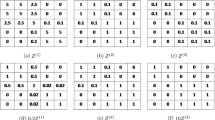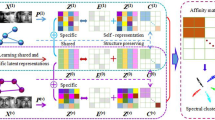Abstract
Multi-view data are generally collected from distinct sources or domains characterized by consistent and specific properties. However, most existing multi-view subspace clustering approaches solely encode the self-representation structure through consistent representation or a set of specific representations, leaving the knowledge of the individual view unexploited and resulting in bad performance in self-representation structure. To address this issue, we propose a novel subspace clustering strategy in which the self-representation structure is contemplated through consistent and specific representations. Specifically, we apply the low-rank sparse representation scenario to uncover the global shared representation structure among all the views and deploy the nearest neighboring method to preserve the geometrical structure according to the consistent and specific representation. The \(L_1\)-norm and frobenius norm are applied to the consistent and specific representation to promote a sparser solution and guarantee a grouping effect. Besides, a novel objective function is figured out, which goes under the optimization process through the alternating direction technique to evaluate the optimal solution. Finally, experiments conducted on several benchmark datasets show the effectiveness of the proposed method over several state-of-the-art algorithms.








Similar content being viewed by others
Notes
References
Hu J, Hu Z, Li T, Du S (2023) A contrastive learning based universal representation for time series forecasting. Inf Sci 635:86–98
Alloghani M, Al-Jumeily D, Mustafina J, Hussain A, Aljaaf AJ (2020) “A systematic review on supervised and unsupervised machine learning algorithms for data science.” Supervised and Unsupervised Learning, pp. 3–21
Huang S, Kang Z, Tsang IW, Xu Z (2019) Auto-weighted multi-view clustering via kernelized graph learning. Pattern Recogn 88:174–184
Diallo B, Hu J, Li T, Khan GA, Liang X, Zhao Y (2021) Deep embedding clustering based on contractive autoencoder. Neurocomputing 433:96–107
Vidal R (2011) Subspace clustering. IEEE Signal Proc Mag 28(2):52–68
Qu W, Xiu X, Chen H, Kong L (2023) A Survey on High-Dimensional Subspace Clustering. Mathematics 11(2):436
Wang S, Chen Y, Ce Y, Zhang L, Voronin V (2021) “Low-rank and sparse tensor representation for multi-view subspace clustering.” In: Proc. of International Conference on Image Processing (ICIP) pp. 1534–1538
Wang S, Chen Y, Cen Y, Zhang L, Wang H, Voronin V (2022) Nonconvex low-rank and sparse tensor representation for multi-view subspace clustering. Appl Intell 52(13):14651–14664
Cai X, Huang D, Zhang GY, Wang CD (2023) Seeking commonness and inconsistencies: A jointly smoothed approach to multi-view subspace clustering. Inform Fusion 91:364–375
Kang Z, Lin Z, Zhu X, Xu W (2021) Structured graph learning for scalable subspace clustering: From single view to multiview. IEEE Trans Cybern 52(9):8976–8986
Zhang GY, Zhou YR, Wang CD, Huang D, He XY (2021) Joint representation learning for multi-view subspace clustering. Expert Syst Appl 166:113913
Meng X, Feng L, Wang HH (2021) Multi-view Low-rank Preserving Embedding: A novel method for multi-view representation. Eng Appl Artif Intell 99:104140
Elhamifar E, Vidal R (2013) Sparse subspace clustering: Algorithm, theory, and applications. IEEE Trans Pattern Anal Mach intell 35(11):2765–2781
Zhu W, Peng B (2020) Sparse and low-rank regularized deep subspace clustering. Knowl-Based Syst 204:106199
Khan GA, Hu J, Li T, Diallo B, Zhao Y (2021) “Multi-view low rank sparse representation method for three-way clustering.” Int J Mach Learn Cybern pp. 1–21
Chen Y, Wang S, Peng C, Hua Z, Zhou Y (2021) Generalized Nonconvex Low-Rank Tensor Approximation for Multi-View Subspace Clustering. IEEE Trans Image Process 30:4022–4035
Wang Y, Chen C, Lai J, Fu L, Zhou Y, Zheng Z (2023) A self-representation method with local similarity preserving for fast multi-view outlier detection. ACM Trans Knowl Disc Data 17(1):1–20
Zheng Q, Zhu J, Li Z, Pang S, Wang J, Li Y (2020) Feature concatenation multi-view subspace clustering. Neurocomputing 379:89–102
Zhu W, Peng B (2020) Sparse and low-rank regularized deep subspace clustering. Knowl-Based Syst 204:106199
Chen Y, Wang S, Zheng F, Cen Y (2020) Graph-regularized least squares regression for multi-view subspace clustering. Knowl-Based Syst 194:105482
Wu Z, Yin M, Zhou Y, Fang X, Xie S (2018) Robust spectral subspace clustering based on least square regression. Neural Processing Lett 48(3):1359–1372
Luo S, Zhang C, Zhang W, Cao X (2018) “Consistent and specific multi-view subspace clustering.” In: Proc. of AAAI Conference Artificial Intelligence, pp. 3730—3737
Wen J, Xu Y, Li Z, Ma Z, Xu Y (2018) Inter-class sparsity based discriminative least square regression. Neural Netw 102:36–47
Zhang GY, Wang CD, Huang D, Zheng WS, Zhou YR (2018) TW-Co-k-means: Two-level weighted collaborative \(k\)-means for multi-view clustering. Knowl-Based Syst 150:127–138
Khan GA, Hu J, Li T, Diallo B, Wang H (2021) “Multi-view data clustering via non-negative matrix factorization with manifold regularization.” Int J Mach Learn Cybern pp. 1–13
Zhao X, Yan W, Ren J, Xu J, Liu Z, Yue G, Tang C (2023) Graph-filtering and high-order bipartite graph based multiview graph clustering. Digit Signal Process 133:103847
Rong W, Zhou E, Peng H, Chen J, Wang H, Han C, Cai H (2021) Learning a consensus affinity matrix for multi-view clustering via subspaces merging on Grassmann manifold. Inf Sci 547:68–87
Kang Z, Zhao X, Peng C, Zhu H, Zhou JT, Peng X, Xu Z (2020) Partition level multiview subspace clustering. Neural Netw 122:279–288
Zhang C, Fu H, Hu Q, Cao X, Xie Y, Tao D, Xu D (2018) Generalized latent multi-view subspace clustering. IEEE Trans Pattern Anal Mach Intell 42(1):86–99
Cai B, Lu GF (2022) Tensor subspace clustering using consensus tensor low-rank representation. Inf Sci 609:46–59
Chen Y, Xiao X, Zhou Y (2020) Multi-view subspace clustering via simultaneously learning the representation tensor and affinity matrix. Pattern Recogn 106:107441
Wang S, Chen Y, Zheng F (2021) Weighted Low-Rank Tensor Representation for Multi-View Subspace Clustering. Front Phys 8:639
Lu GF, Yu QR, Yang Y, Tang G (2020) Hyper-Laplacian regularized multi-view subspace clustering with low-rank tensor constraint. Neural Netw 125:214–223
Shen Y, Wen Z, Zhang Y (2014) Augmented lagrangian alternating direction method for matrix separation based on low-rank factorization. Optim Methods Softw 29:239–263
Cai JF, Candès EJ, Shen Z (2010) A singular value thresholding algorithm for matrix completion. SIAM J Optim 20(4):1956–1982
Ng A, Jordan M, Weiss Y (2001) On spectral clustering: Analysis and an algorithm. Adv Neural Inf Process Syst 14:849–856
Huang S, Tsang I, Xu Z, Lv JC (2021) “Measuring Diversity in Graph Learning: A Unified Framework for Structured Multi-view Clustering.” IEEE Trans Knowl Data Eng
Zhao K, Wangtao Z, Zhitong Z, Junming S, Meng H, Zenglin X (2020) “Large-scale Multi-view Subspace Clustering in Linear Time.” In: Proc. of 34th AAAI Conference on Artificial Intelligence, AAAI, pp. 4412–4419
Liang N, Yang Z, Li Z, Sun W, Xie S (2020) Multi-view clustering by non-negative matrix factorization with co-orthogonal constraints. Knowl-Based Syst 194:105582
Brbic M, Kopriva I (2018) Multi-view low-rank sparse subspace clustering. Pattern Recog 73:247–258
Zhou T, Zhang C, Peng X, Bhaskar H, Yang J (2019) Dual shared-specific multiview subspace clustering. IEEE Trans Cybern 50(8):3517–3530
Wang X, Lei Z, Guo X, Zhang C, Shi C, Li H, Stan Z (2019) Multi-view subspace clustering with intactness-aware similarity. Pattern Recogn 88:50–63
Zhang P, Liu X, Xiong J, Zhou S, Zhao W, Zhu E, Cai Z (2020) “Consensus One-step Multi-view Subspace Clustering.” IEEE Trans Knowl Data Eng pp. 1–1
Li R, Zhang C, Hu Q, Zhu P, Wang Z (2019) “Flexible Multi-View Representation Learning for Subspace Clustering.” In: Proc. of 28th International Joint Conference on Artificial Intelligence, (IJCAI), pp. 2916–2922
Luong K, Nayak R, Thirunavukarsu B, Bashar MB (2022) “Multi-layer Manifold Learning for Deep Non-negative Matrix Factorization-Based Multi-View Clustering.” Pattern Recogn pp. 108815
Lvd Maaten, Hinton G (2008) Visualizing data using t-SNE. J Mach Learn Res 9:2579–2605
Acknowledgements
This work was supported by the National Natural Science Foundation of China (Nos. 62176221, 62276215, 62272398, 61976182), Sichuan Science and Technology Program (No. 2023YFG0354), and the Key Research and Development Program of Sichuan Province (Nos. 23ZDYF0090, 2022YFG0028).
Author information
Authors and Affiliations
Corresponding authors
Ethics declarations
Conflicts of interest/Competing interests
The authors declare that they have no known competing financial interests or personal relationships that could have appeared to influence the work reported in this paper.
Additional information
Publisher's Note
Springer Nature remains neutral with regard to jurisdictional claims in published maps and institutional affiliations.
All author’s are contributed equally to this work.
Rights and permissions
Springer Nature or its licensor (e.g. a society or other partner) holds exclusive rights to this article under a publishing agreement with the author(s) or other rightsholder(s); author self-archiving of the accepted manuscript version of this article is solely governed by the terms of such publishing agreement and applicable law.
About this article
Cite this article
Khan, G.A., Hu, J., Li, T. et al. Multi-view subspace clustering for learning joint representation via low-rank sparse representation. Appl Intell 53, 22511–22530 (2023). https://doi.org/10.1007/s10489-023-04716-z
Accepted:
Published:
Issue Date:
DOI: https://doi.org/10.1007/s10489-023-04716-z




